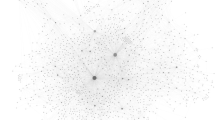Abstract
Social networks are an example of complex systems consisting of nodes that can interact with each other and based on these activities the social relations are defined. The dynamics and evolution of social networks are very interesting but at the same time very challenging areas of research. In this paper the formation and growth of one of such structures extracted from data about human activities within online social networking system is investigated. Dynamics of both local and global characteristics are studied. Analysis of the dynamics of the network growth showed that it changes over time—from random process to power-law growth. The phase transition between those two is clearly visible. In general, node degree distribution can be described as the scale-free but it does not emerge straight from the beginning. Social networks are known to feature high clustering coefficient and friend-of-a-friend phenomenon. This research has revealed that in online social network, although the clustering coefficient grows over time, it is lower than expected. Also the friend-of-a-friend phenomenon is missing. On the other hand, the length of the shortest paths is small starting from the beginning of the network existence so the small-world phenomenon is present. The unique element of the presented study is that the data, from which the online social network was extracted, represents interactions between users from the beginning of the social networking site existence. The system, from which the data was obtained, enables users to interact using different communication channels and it gives additional opportunity to investigate multi-relational character of human relations.
Article PDF
Similar content being viewed by others
Avoid common mistakes on your manuscript.
References
Barabasi, A.L.: Linked: How Everything is Connected to Everything else and What it Means. Plume (2003)
Barrat, A., Barthelemy, M., Vespignani, A.: Dynamical Processes on Complex Networks. Cambridge University Press (2008)
Bisgin, H., Agarwal, N., Xu, X.: A study of homophily on social media. World Wide Web 15(2), 213–232 (2012)
Bollobas, B.: Random Graphs. Academic, London (1985)
Braha, D., Bar-Yam, Y.: From centrality to temporary fame: dynamic centrality in complex networks. Complexity 12, 59–63 (2006)
Breiger, R.: The analysis of social networks. In: Handbook of Data Analysis, pp. 505–526. SAGE Publications (2004)
Bringmann, B., Berlingero, M., Bonch, F., Gionis, A.: Learning and predicting the evolution of social networks. IEEE Intell. Syst. 25(4), 26–35 (2010)
Carrington, P., Scott, J., Wasserman, S.: Social networks. In: Models and Methods in Social Network Analysis. Cambridge University Press, Cambridge (2005)
Fredericks, K., Durlan, M.: The historical evolution and basic concepts of social network analysis. New Dir. Eval. 2005(107), 15–23 (2006)
Hill, S., Braha, D.: Dynamic model of time-dependent complex networks. Phys. Rev. E 82, 046105 (2010). arXiv:0901.4407v2
Holland, J.: Hidden Order: How Adaptation Builds Complexity. Basic Books (1996)
Kazienko, P., Musial, K., Kajdanowicz, T.: Multidimensional social network and its application to the social recommender system. IEEE Trans. Syst. Man Cybern., Part A, Syst. Humans 41(4), 746–759 (2011)
Kazienko, P., Musial, K., Brodka, P., Skibicki, K.: Analysis of neighbourhoods in multi-layered social networks. J. Comput. Intell. Syst. 5(3), 582–596 (2012). doi:10.1080/18756891.2012.696922
Kumar, R., Novak, J., Tomkins, A.: Microscopic evolution of social network. In: The 14th ACM SIGKDD International Conference on Knowledge Discovery and Data Mining. ACM Press (2006)
Lescovec, J., Backstrom, L., Kumar, R., Tomkins, A.: Microscopic evolution of social networks. In: ACM SIGKDD International Conference on Knowledge Discovery and Data Mining (KDD) (2008)
Liben-Nowell, D., Kleinberg, J.: The link-prediction problem for social networks. J. Am. Soc. Inf. Sci. Technol. 58(7), 1019–1031 (2007)
Musial, K., Kazienko, P.: Social networks on the internet. World Wide Web J. 1–42 (2012). doi:10.1007/s11280-011-0155-z, online first
Musial, K., Sastry, N.: Social media—are they underpinned by social or interest-based interactions? In: 4th Annual Workshop on Simplifying Complex Networks for Practitioners (SIMPLEX2012) Co-Located with World Wide Web Conference (WWW2012) (2012)
Newman, M.E.J.: Assortative mixing in networks. Phys. Rev. E 89(20), 208701 (2002)
Newman, M., Park, J.: Why social networks are different from other types of networks. Phys. Rev. E 68(3), 036122 (2003)
Shen, H.T., Hua, X.S., Luo, J., Oria, V.: Guest editorial: content, concept and context mining in social media. World Wide Web 15(2), 115–116 (2012)
Time.com: One minute on Facebook—person of the year 2010—Time (2011)
Wasserman, S., Faust, K.: Social Network Analysis Methods and Applications. Cambridge University Press, New York (1994)
Watts, D.: Small Worlds Dynamic of Networks between Order and Randomness. Princeton University Press (2002)
Watts, D., Strogatz, S.: Collective dynamics of small-world networks. Nature 393(6684), 440–444 (1998)
Yao, J., Cui, B., Huang, Y., Zhou, Y.: Bursty event detection from collaborative tags. World Wide Web 15(2), 171–195 (2012)
Zhong, N., Liu, J., Yao, Y.Y.: In search of the Wisdom Web. IEEE Computer 35(11), 27–31 (2002)
Zhong, N., Liu, J., Yao, Y.Y.: Web Intelligence (WI). In: The Encyclopedia of Computer Science and Engineering, vol. 5, pp. 3062–3072. Wiley (2009)
Zhong, N., Ma, J.H., Huang, R.H., Liu, J.M., Yao, Y.Y., Zhang, Y.X., Chen, J.H.: Research challenges and perspectives on Wisdom Web of Things (W2T). J. Supercomputing (Springer) (2010). doi:10.1007/s11227-010-0518-8
Author information
Authors and Affiliations
Corresponding author
Rights and permissions
Open Access This article is distributed under the terms of the Creative Commons Attribution 2.0 International License (https://creativecommons.org/licenses/by/2.0), which permits unrestricted use, distribution, and reproduction in any medium, provided the original work is properly cited.
About this article
Cite this article
Musial, K., Budka, M. & Juszczyszyn, K. Creation and growth of online social network. World Wide Web 16, 421–447 (2013). https://doi.org/10.1007/s11280-012-0177-1
Received:
Revised:
Accepted:
Published:
Issue Date:
DOI: https://doi.org/10.1007/s11280-012-0177-1




